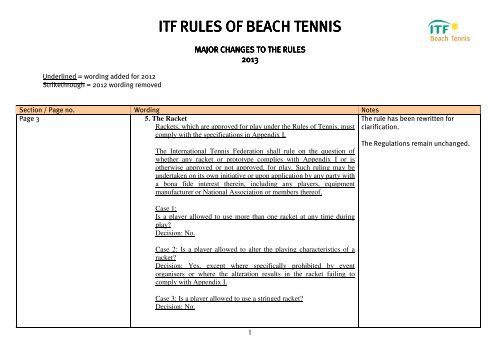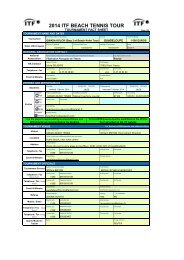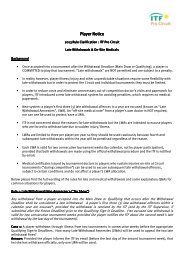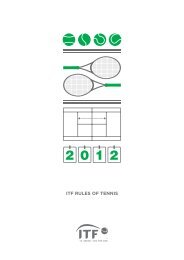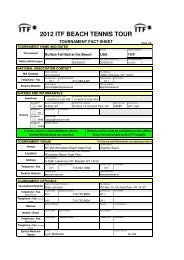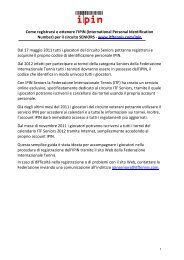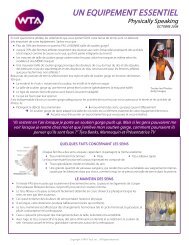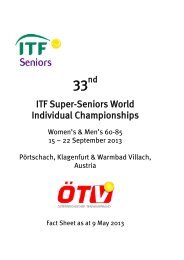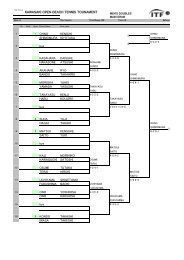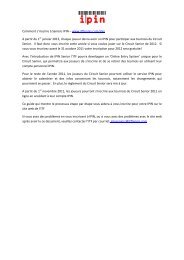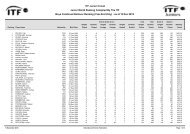itf rules of beach tennis rules of beach tennis rules of beach tennis
itf rules of beach tennis rules of beach tennis rules of beach tennis
itf rules of beach tennis rules of beach tennis rules of beach tennis
Create successful ePaper yourself
Turn your PDF publications into a flip-book with our unique Google optimized e-Paper software.
Underlined = wording added for 2012<br />
Strikethrough = 2012 wording removed<br />
ITF RULES OF BEACH TENNIS<br />
MAJOR CHANGES TO THE RULES<br />
2013<br />
Section / Page no. Wording Notes<br />
Page 3<br />
5. The Racket<br />
Rackets, which are approved for play under the Rules <strong>of</strong> Tennis, must<br />
comply with the specifications in Appendix I.<br />
The rule has been rewritten for<br />
clarification.<br />
The International Tennis Federation shall rule on the question <strong>of</strong><br />
whether any racket or prototype complies with Appendix I or is<br />
otherwise approved or not approved, for play. Such ruling may be<br />
undertaken on its own initiative or upon application by any party with<br />
a bona fide interest therein, including any players, equipment<br />
manufacturer or National Association or members there<strong>of</strong>.<br />
Case 1:<br />
Is a player allowed to use more than one racket at any time during<br />
play?<br />
Decision: No.<br />
Case 2: Is a player allowed to alter the playing characteristics <strong>of</strong> a<br />
racket?<br />
Decision: Yes, except where specifically prohibited by event<br />
organisers or where the alteration results in the racket failing to<br />
comply with Appendix I.<br />
Case 3: Is a player allowed to use a stringed racket?<br />
Decision: No.<br />
The Regulations remain unchanged.<br />
1
Page 5<br />
9. Server and Receiver<br />
Page 7<br />
Page 8<br />
Case 3. Will a player who runs after a ball lose the point for his/her<br />
doubles team if he/she crosses the line which runs parallel to the net,<br />
but outside the lines <strong>of</strong> the court, prior to or after hitting the ball?<br />
Decision. No. A player will only lose the point for his/her doubles<br />
team if he/she steps into the opposing team’s playing area prior to or<br />
after hitting the ball while the ball is in play.<br />
19. Foot Fault<br />
During the service motion, the server shall not:<br />
a. Change position by walking or running, although slight<br />
movements <strong>of</strong> the feet are permitted; or<br />
b. Touch the court inside the baseline with the standing/front foot;<br />
or<br />
c. Touch the baseline or the court with the drag/rear foot; or<br />
d. Place either foot on or under the baseline; or<br />
e. Touch the area outside the imaginary extension <strong>of</strong> the side line<br />
with either foot<br />
Case 1. Is the server allowed to have one or both feet <strong>of</strong>f the ground?<br />
Decision. Yes.<br />
Case 2. Is it a fault if the server’s standing/front foot touches the<br />
baseline during the service motion?<br />
Decision. As long as both the server’s feet are behind the baseline<br />
prior to the start <strong>of</strong> the service motion, no foot fault is committed if<br />
his standing/front foot touches the baseline during the service<br />
motion.<br />
Case 3. Is it a fault if the baseline moves because <strong>of</strong> sand pushed by<br />
the server during the service motion?<br />
Decision. No.<br />
Rule 24 Team Loses Point<br />
Case 3: Is a member <strong>of</strong> a doubles team allowed to jump over the net<br />
2<br />
Clarification.<br />
Additional case study added for<br />
clarification
into the opposing team’s court while the ball is in play?<br />
Decision: No. The doubles team loses the point.<br />
Page 12 Appendix 1<br />
The Racket<br />
For all measurements in Appendix I, SI units shall take precedence.<br />
The <strong>beach</strong> <strong>tennis</strong> racket must conform to all <strong>of</strong> the requirements<br />
below:<br />
a. The hitting surface, defined as the flat area <strong>of</strong> the racket head<br />
bounded by the inner edge <strong>of</strong> the rim or holes larger than 13mm<br />
in diameter, whichever is smaller, must not exceed 30cm in<br />
length and 26 cm in width.<br />
b. The racket must not exceed 50cm in length from the butt <strong>of</strong> the<br />
handle to the tip <strong>of</strong> the racket head. The racket head must not<br />
exceed 26cm in width.<br />
c. The pr<strong>of</strong>ile distance between the two hitting surfaces (thickness)<br />
must be constant and must not exceed 38mm.<br />
d. Holes greater than 13mm in diameter must not extend over<br />
40mm from the rim <strong>of</strong> the racket, with the exception <strong>of</strong> holes that<br />
form part <strong>of</strong> the throat.<br />
e. The racket must be free from any device that may provide<br />
communication, advice or instruction <strong>of</strong> any kind, audible or<br />
visible, to a player during a match.<br />
3


